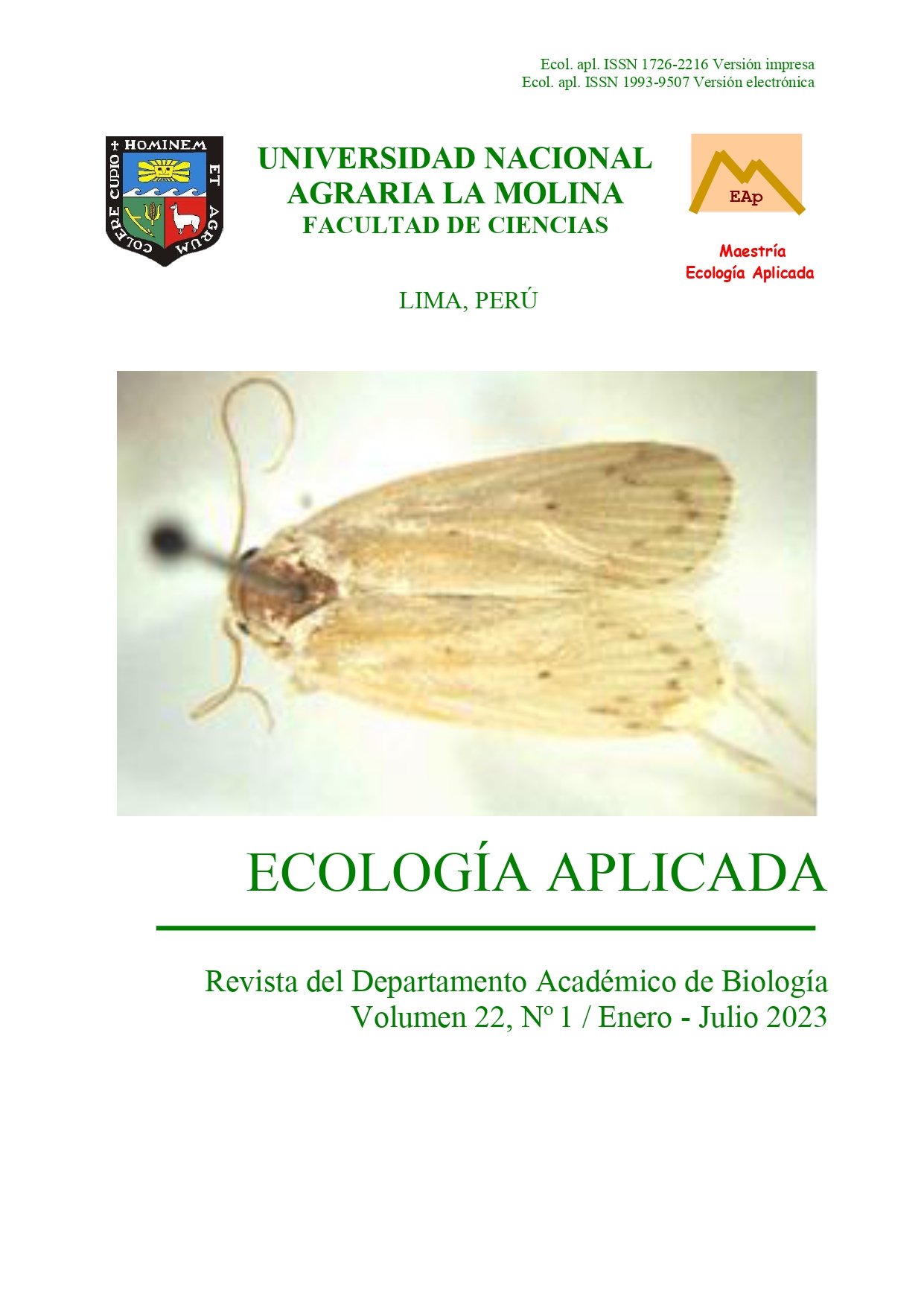RELATIONSHIP BETWEEN PARTICULATE MATTER (PM10), METEOROLOGICAL PARAMETERS, AND THE CONCENTRATION OF FUNGAL SPORES IN THE ATMOSPHERE OF SAN MARTÍN SQUARE IN LIMA
DOI:
https://doi.org/10.21704/rea.v22i1.1927Keywords:
particulate matter, PM10, bioaerosol, spores, fungi, meteorological variablesAbstract
The relationship between the concentration of particulate matter with aerodynamic diameter ≤ 10 µm (PM10), meteorological variables (air temperature, relative humidity, UV index, and wind speed), and the concentration of total fungal spores in the outdoor air of Plaza San Martin in Lima was studied. The sampling of fungal spores was performed using a single-stage Andersen-type volumetric impact equipment; PM10 values were provided by the Mobile Station of La Colmena (PROTRANSPORTE – Municipality of Lima). The results show that the concentrations of PM10 were highest in the months of March and April, which coincide with the highest concentrations of total spores, and continuously decreased to a minimum in the months of June and July. PM10 concentration showed a strong positive correlation with total spore concentration. Regarding the influence of meteorological variables on the concentration of PM10, a non-significant positive correlation was found with wind speed (r = 0.727). Air temperature and UV index presented a positive correlation with a significance level p < 0.001. Concerning relative humidity (RH), PM10 presented a negative correlation with a significance level p < 0.05. Further studies are required to evaluate the concentrations of PM10 in relation to the concentrations of fungal spores in the atmosphere of San Martin Square.
Downloads
References
Adhikari A., Reponen T., Grinshpun S., Martuzevicius D. & LeMasters G. 2006. Correlation of ambient inhalable bioaerosols with particulate matter and ozone: A two-year study. Environmental Pollution, 140(1): 16–28. https://doi.org/10.1016/j.envpol.2005.07.004.
Andersen A. 1958. New sampler for the collection, sizing and enumeration of viable airborne particles. Journal of Bacteriology, 76(5): 471–484. https://doi.org/10.1128/jb.76.5.471-484.1958.
Bardtke D., Baader W., Tietjen C. & Strauch D. 1977. Abfälle aus der Tierhaltung-Anfall, Umwelt- belastung, Behandlung, Verwertung. Ulmer Verlag, Stuttgart. https://www.openagrar.de/receive/timport_mods_00008 616.
Barnett H. & Hunter B. 1998. Illustrated genera of Imperfect Fungi. 4th Ed. APS Press, Saint Paul, Minnesota.
Boreson J., Dillner A. M. & Peccia J. 2004. Correlating bioaerosol load with PM2.5 and PM10cf concentrations: A comparison between natural desert and urban-fringe aerosols. Atmospheric Environment, 38(35): 6029–6041. https://doi.org/10.1016/j.atmosenv.2004.06.040.
Cao C., Jiang W., Wang B., Fang J., Lang J., Tian G., Jiang J. & Zhu T.F. 2014. Inhalable Microorganisms in Beijing’s PM2.5 and PM10 Pollutants during a Severe Smog Event. Environmental Science & Technology, 48(3): 1499–1507. https://doi.org/10.1021/es4048472.
Ediagbonya T., Ukpebor E. & Okieimen F. 2013. The Influence of Meteorological Parameters on Respirable and Inhalabe Particle During Wet Season. Journal of Applied Sciences and Environmental Management, 17(4): 441–448. https://www.bioline.org.br/abstract?id=ja13050&lang=e n.
Elminir H.K. 2005. Dependence of urban air pollutants on meteorology. Science of the Total Environment, 350(1– 3): 225–237. https://doi.org/10.1016/j.scitotenv.2005.01.043.
Ghosh B., Lal H. & Srivastava A. 2015. Review of bioaerosols in indoor environment with special reference to sampling, analysis and control mechanisms. Environment International, 85: 254–272. https://doi.org/10.1016/j.envint.2015.09.018.
Glikson M., Rutherford S., Simpson R. W., Mitchell C. A. & Yago A. 1995. Microscopic and submicron components of atmospheric particulate matter during high asthma periods in Brisbane, Queensland, Australia. Atmospheric Environment, 29(4): 549–562. https://doi.org/10.1016/1352-2310(94)00278-S.
González-Duque C.M., Cortés-Araujo J. & Aristizábal-Zuluaga B.H. 2015. Influence of meteorology and source variation on airborne PM10 levels in a high relief tropical Andean city. Revista Facultad de Ingenieria, (74): 200– 212. https://revistas.udea.edu.co/index.php/ingenieria/article/ view/18616.
Gulshan J.E., Hossain S.A., Hossain M.E., Islam M.M., Emon S.Z., Manzum A.A., Jashim Z.B. & Huda M.N. 2021. Seasonal variations of microbes in particulate matter obtained from Dhaka City in Bangladesh. Environmental Pollutants and Bioavailability, 33(1): 122–134. https://doi.org/10.1080/26395940.2021.1940302.
Gupta A., Moniruzzaman M., Hande A., Rousta I., Olafsson H. & Mondal K. K. 2020. Estimation of particulate matter (PM2.5, PM10) concentration and its variation over urban sites in Bangladesh. SN Applied Sciences, 2(12): 1993. https://doi.org/10.1007/s42452-020-03829-1.
Haas D., Galler H., Luxner J., Zarfel G., Buzina W., Friedl H., Marth E., Habib J. & Reinthaler F.F. 2013. The concentrations of culturable microorganisms in relation to particulate matter in urban air. Atmospheric Environment, 65: 215–222. https://doi.org/10.1016/j.atmosenv.2012.10.031.
Hosler C.R. 1961. Low-level inversion frequency in the contiguous United States. Monthly Weather Review, 89(9): 319–339. https://doi.org/10.1175/1520- 0493(1961)0892.0.CO;2.
Ibald-Mulli A., Wichmann H.E., Kreyling W. & Peters A. 2002. Epidemiological evidence on health effects of ultrafine particles. Journal of Aerosol Medicine, 15(2): 189-201. https://doi.org/10.1089/089426802320282310.
Jayamurugan R., Kumaravel B., Palanivelraja S. & Chockalingam M. P. 2013. Influence of Temperature, Relative Humidity and Seasonal Variability on Ambient Air Quality in a Coastal Urban Area. International Journal of Atmospheric Sciences, 2013: Article ID 264046. https://doi.org/10.1155/2013/264046.
Kayes I., Shahriar S.A., Hasan K., Akhter M., Kabir M.M. & Salam M.A. 2019. The relationships between meteorological parameters and air pollutants in an urban environment. Global Journal of Environmental Science and Management, 5(3): 265–278. https://doi.org/10.22034/gjesm.2019.03.01.
Kirešová S. & Guzan M. 2022. Determining the Correlation between Particulate Matter PM10 and Meteorological Factors. Eng, 3(3): 343–363. https://doi.org/10.3390/eng3030025.
Kliengchuay W., Meeyai A.C., Worakhunpiset S. & Tantrakarnapa K. 2018. Relationships between meteorological parameters and particulate matter in Mae Hong Son province, Thailand. International Journal of Environmental Research and Public Health, 15(12): 2801. https://doi.org/10.3390/ijerph15122801.
Kliengchuay W., Srimanus R., Srimanus W., Niampradit S., Preecha N., Mingkhwan R., Worakhunpiset S., Limpanont Y., Moonsri K. & Tantrakarnapa K. 2021. Particulate matter (PM10) prediction based on multiple linear regression: a case study in Chiang Rai Province, Thailand. BMC Public Health, 21(1): Art. 2149. https://doi.org/10.1186/s12889-021-12217-2.
Köck M., Schlacher R., Pichler-Semmelrock F.P., Reinthaler F.F., Eibel U., Marth E. & Friedl H. 1998. Airborne microorganisms in the metropolitan area of Graz, Austria. Central European Journal of Public Health, 6(1): 25-28.
Kumar P., Hama S., Nogueira T., Abbass R.A., Brand V.S., Andrade M. de F., Asfaw A., Aziz K.H., Cao S.J., El Gendy A., Islam S., Jeba F., Khare M., Mamuya S.H., Martinez J., Meng M.R., Morawska L., Muula A.S., Shiva Nagendra S.M., Ngowi A.V., Omer K., Olaya Y., Osano P. & Salam A. 2021. In-car particulate matter exposure across ten global cities. Science of The Total Environment, 750: 141395. https://doi.org/10.1016/j.scitotenv.2020.141395.
Neuberger M., Schimek M.G., Horak Jr. F., Moshammer H., Kundi M., Frischer Th., Gomiscek B., Puxbaum H., Hauk H. & AUPHEP-Team. 2004. Acute effects of particulate matter on respiratory diseases, symptoms and functions: epidemiological results of the Austrian Project on Health Effects of Particulate Matter (AUPHEP). Atmospheric Environment, 38(24): 3971-3981. https://doi.org/10.1016/j.atmosenv.2003.12.044.
Raisi L., Aleksandropoulou V., Lazaridis M. & Katsivela E. 2013. Size distribution of viable, cultivable, airborne microbes and their relationship to particulate matter concentrations and meteorological conditions in a Mediterranean site. Aerobiologia, 29(2): 233–248. https://doi.org/10.1007/s10453-012-9276-9.
Ramos R. & Meza V. 2017. Efectos de algunos factores meteorológicos sobre la concentración de esporas de hongos en la Plaza San Martín de Lima. Ecología Aplicada, 16(2): 143-149. http://dx.doi.org/10.21704/rea.v16i2.1018.
Sánchez-Ccoyllo O., Ordoñez-Aquino C., Aliaga-Martínez R. & Rojas-Quincho J. 2015. Evaluación de la Calidad del Aire en Lima Metropolitana, 2014. Lima: Servicio Nacional de Meteorología e Hidrología del Perú. https://www.senamhi.gob.pe/load/file/01403SENA 6.pdf.
Shapiro S.S. & Wilk M.B. 1965. An analysis of variance test for normality (Complete Samples). Biometrika, 52(3-4): 591–611. https://doi.org/10.2307/2333709.
Sirithian D. & Thanatrakolsri P. 2022. Relationships between Meteorological and Particulate Matter Concentrations (PM2.5 and PM10) during the Haze Period in Urban and Rural Areas, Northern Thailand. Air, Soil and Water Research, 15(1): 1–15. https://doi.org/10.1177/11786221221117264.
WHO. 2021. World Health Organization: Ambient (outdoor) air pollution. Accessed 13st May 2022 from: https://www.who.int/news-room/factsheets/detail/ambient-(outdoor)-air-quality-and-health.
Zhai Y., Li X., Wang T., Wang B., Li C. & Zeng G. 2018. A review on airborne microorganisms in particulate matters: Composition, characteristics and influence factors. Environment International, 113: 74–90. https://doi.org/10.1016/j.envint.2018.01.007.
Zhai Y., Li X., Wang T., Wang B., Li C. & Zeng G. 2018. A review on airborne microorganisms in particulate matters: Composition, characteristics and influence factors. Environment International, 113: 74–90. https://doi.org/10.1016/j.envint.2018.01.007.
Downloads
Published
Issue
Section
License
Copyright (c) 2023 Roberto Ramos

This work is licensed under a Creative Commons Attribution-NonCommercial 4.0 International License.



